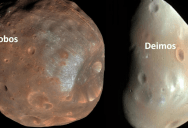Planned Mission To Mars May Help Discover How Its Two Small Moons Were Formed

People have been fascinated with the planet Mars for hundreds of years, and even more so recently due to the probes and rovers that have been sent there.
Of the many mysteries that Mars holds, one of the most interesting is actually related to its two small moons, Phobos and Deimos. These moons are misshapen and have a different look compared to the moons of other planets, which has led astrologists to wonder how they were formed.
There have been many theories on the subject.
One popular option is that they were formed the same way that our Moon was, when a large object crashed into the planet and the debris settled and formed them.
Another option is that passing asteroids were caught by the gravitational field of Mars and have been orbiting ever since.
The second explanation is graining additional traction thanks to a recent study performed by a team of French and German scientists.
They claim that the two moons may actually have been formed from the same comet that broke apart while passing by, then were held in orbit around Mars.
In their study, they look at data gathered by the Mars Express Spacecraft between 2004 and 2022. Looking at the data, they found that Phobos has similar properties to known comets that have orbits heavily influenced by Jupiter.
Astronomers are hoping to be able to learn more about these moons, and possibly confirm this theory, in the near future thanks to a planned mission that Japan is working on.
The Martian Moons eXploration (MMX) mission will involve a spacecraft that is being built specifically to study the two moons.

It will first orbit Phobos taking photos and gathering other information. Once done, it will move on to repeat this process around Deimos and then Mars.
Finally, the craft will land on the surface of Phobos to collect a variety of different samples before launching on a return trip to Earth.
There is not a set launch date for this mission yet, but it is hoped that it will take place within the next few years.
Studying the red planet may help unlock many of its mysteries.
If you thought that was interesting, you might like to read a story that reveals Earth’s priciest precious metal isn’t gold or platinum and costs over $10,000 an ounce!

Sign up to get our BEST stories of the week straight to your inbox.




